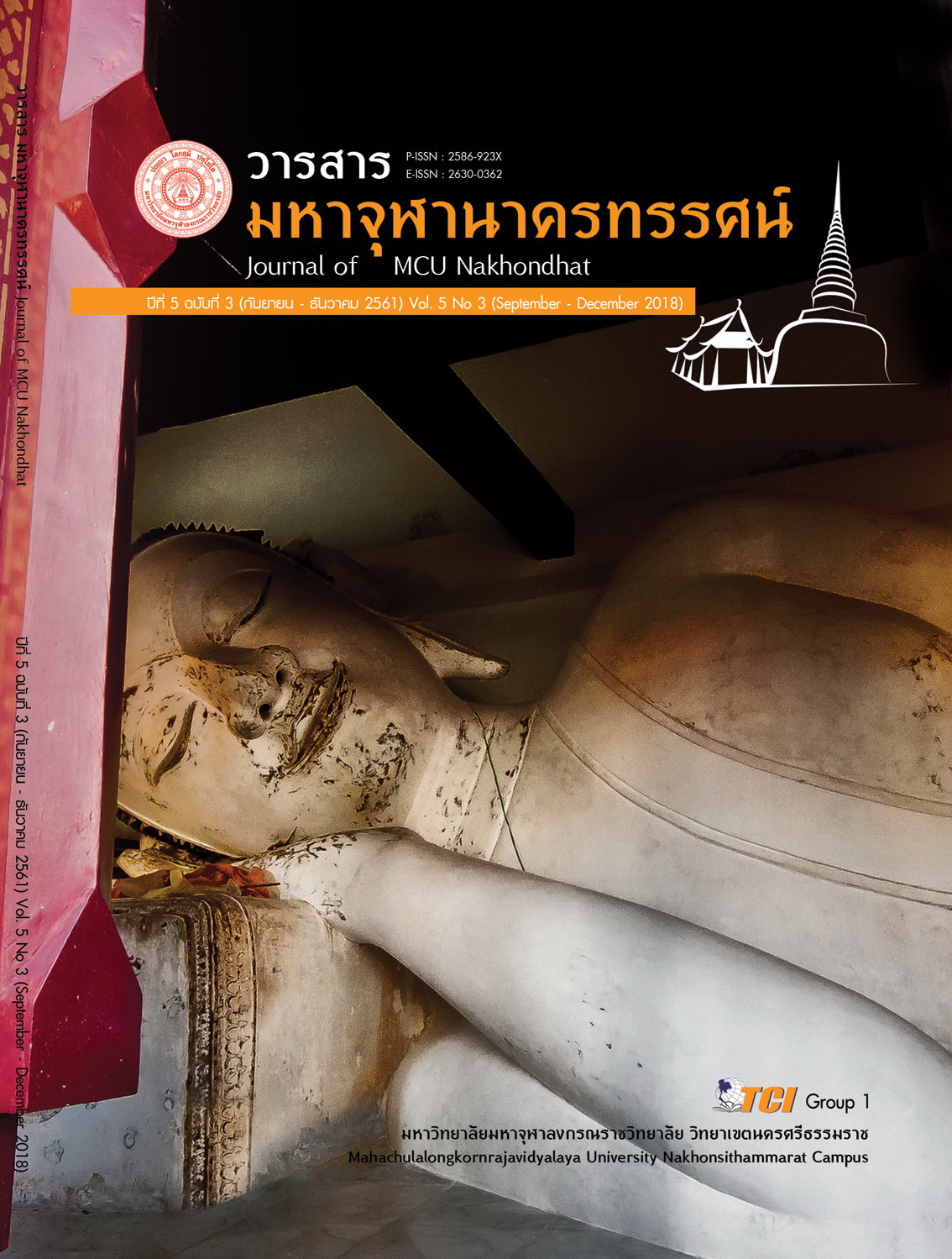FUNERAL MANAGEMENT AND UNDERTAKER IDENTIFICATION IN CONTEXT OF NA IN SOUTH AREA CASE STUDY OF WATMATCHIMPHUPHA (DONKLANG) COMMUNITY, RONPIBOON, NAKHON SI THAMMARAT.
Main Article Content
Abstract
This article has aimed 1) to study the patterns and beliefs of funeral management of Watmatchimphupha (Donklang) community; and 2) to study the identity of the undertaker of Watmatchimphupha (Donklang) community. This study was the qualitative research and set time of study during 1997-2018, collected data from documents and fields in Watmatchimphupha (Donklang) community by using non-participant observation and in-depth interviews from seniors group in the community, monks, and undertakers. The data was classified, interpreted, constructed and presented with descriptive analysis.
The study found that:
During 1997-2018, Watmatchimphupha (Donklang) community has changed social, economy, utility systems, government and private organizations, community organizations and including forms and beliefs in funeral arrangements. It has changed according to the way of society. Funeral atmosphere has well preparation, beauty, elegant, comfortable, the shop service such the flower decoration of coffins with gold paper, coffin with air conditioning. There is organizing a funeral at home and some is located at temple because there are comfortable, save money and time, easier management and the atmosphere in the funeral is lively.
For the identity of undertaker of Watmatchimphupha (Donklang) community found that there has the dynamics changed of the cremation method that means there had Samsang crematorium (bier crematorium) in the past and indefinite the status of the undertaker. After that, there was changing to new crematorium, the undertaker identity is vibrant. Presently, the oven crematorium is the newest crematorium, has changed the position of undertaker to be the "funeral manager" with knowledge of cremation. They have also skilled in taking care, cleaning, and repairing the furnace. Moreover, they are easy to see, fast service, dress well, be brave, not afraid of ghosts, practice in the precepts, no more magic, variety of career, as liaison of praying in all Buddhist’s traditional merits, doing fruits fields. They has the unique certainly identity that still hold the beliefs in philanthropy, refusing the charge of the cremation.
Article Details
References
ธรรมพร สุขมี และเก็ตถวา บุญปราการ. (2558). การประกอบสร้างอัตลักษณ์ของโลงศพในสังคมไทยพุทธสมัยใหม่. การประชุมวิชาการระดับชาติ มหาวิทยาลัยราชภัฎภูเก็ต ครั้งที่ 4ในหัวข้อ“การพัฒนางานวิจัยบนฐานแนวคิดใหม่ เพื่อก้าวสู่ประชาคมอาเซียน ระหว่างวันที่ 7-8 พฤษภาคม (หน้า 46-53). ณ ศูนย์ประชุมมหาวิทยาลัยราชภัฏภูเก็ต: มหาวิทยาลัยราชภัฏภูเก็ต.
บรรเจิด ดำสวัสดิ์. (29 มีนาคม 2561). ความเชื่อเกี่ยวกับประเพณีการตาย. (ผศ. ดำรงศ์พันธ์ ใจห้าววีระพงศ์, ผู้สัมภาษณ์)
พระครูโกศลอรรถกิจ. (ปีที่ 4 เล่มที่ 2 กรกฎาคม-ธันวาคม 2560). ศึกษาประเพณีงานศพของชาวไทยพุทธท้องถิ่น อำเภอสทิงพระ จังหวัดสงขลา. มหาจุฬานาครทรรศน์, 65-82.
พระครูธำรงภูมิธรรม. (19 มีนาคม 2561). ความเชื่อเกี่ยวกับประเพณีการตาย. (ผศ. ดำรงศ์พันธ์ ใจห้าววีระพงศ์, ผู้สัมภาษณ์)
พระชาญชัย ชยเมธี (คำวิชัย). (2556). บทบาทของสัปเหร่อที่มีต่อพิธีงานศพกรณีศึกษา ในเขตเทศบาลตำบลหลวงใต้ อำเภองาว จังหวัดลำปาง. กรุงเทพมหานคร: มหาจุฬาลงกรณ์มหาวิทยาลัย.
พระพิพัฒน์พงษ์ ฐานวุฑโฒ. (2554). การเปลี่ยนแปลงการจัดงานศพของชาวพุทธ กรณีศึกษาบ้านหมุ้นตำบลนาปรัง อำเภอปง จังหวัดพะเยา. วิทยานิพนธ์พุทธศาสตรมหาบัณฑิต สาขาวิชาพระพุทธศาสนา: บัณฑิตวิทยาลัย มหาวิทยาลัยมหาจุฬาลงกรณ์ราชวิทยาลัย.
พระมหาจรัญ จิตตสังวโร. (2553). การศึกษาแนวคิดความเชื่อเชิงวัฒนธรรมในการสร้างปราสาทศพของชาวพุทธล้านนา . พุทธศาสตรมหาบัณฑิต สาขาวิชาพระพุทธศาสนา: บัณฑิตวิทยาลัย มหาวิทยาลัยมหาจุฬาลงกรณ์ราชวิทยาลัย.
สมหมาย สมแก้ว. (31 มีนาคม 2561). ความเชื่อเกี่ยวกับประเพณีการตาย. (ผศ. ดำรงศ์พันธ์ ใจห้าววีระพงศ์, ผู้สัมภาษณ์)
สว่าง เดชสถิต. (3 มีนาคม 2561). ความเชื่อเกี่ยวกับประเพณีการตาย. (ผศ. ดำรงศ์พันธ์ ใจห้าววีระพงศ์, ผู้สัมภาษณ์)
เสถียร โกเศศ. (2553). ประเพณีเกี่ยวกับชีวิตความตาย. นนทบุรี: มหาวิทยาลัยสุโขทัยธรรมาธิราช.
A Giddens. (1992). The Transformation of Intimacy Sexuality, Love, and Eroticism in Modern Societies. Stanfor: Stanford University Press.


